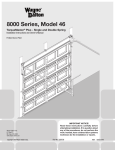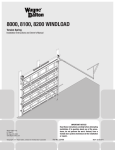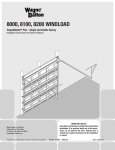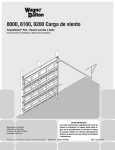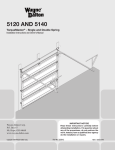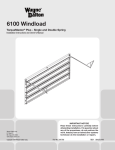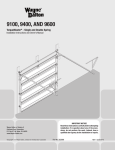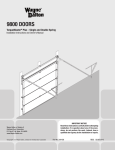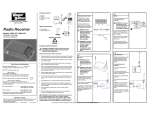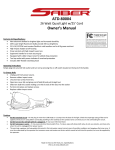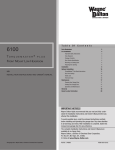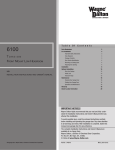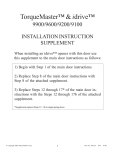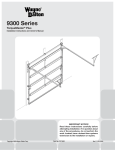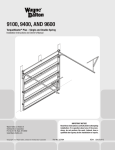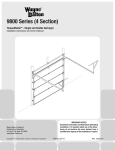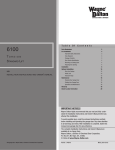Download Wayne-Dalton TORQUEMASTER 9100 User's Manual
Transcript
9100, 9400 and 9600 Series TorqueMaster® Plus - Single and Double Spring Installation Instructions and Owner’s Manual Portland Source Plant Wayne-Dalton Corp. P.O. Box 67 Mt. Hope, OH 44660 www.wayne-dalton.com Copyright 2009 Wayne-Dalton Corp. IMPORTANT NOTICE! Read these instructions carefully before attempting installation. If in question about any of the procedures, do not perform the work. Instead, have a trained door systems technician do the installation or repairs. Part No. 328740 REV1 08/03/2009 Table of Contents Important Safety Instructions............................................. 2 Package Contents.............................................................. 3 Door Section Identification................................................. 4 Tools Required................................................................... 5 Removing an Existing Door................................................ 5 Installation . .................................................................7-28 TorqueMaster® Plus Reset Instructions..........................29-31 Side Lock........................................................ 32 Pull Rope......................................................... 32 Step Plate........................................................ 33 Trolley Installation for Standard Lift................. 34 Trolley Installation for Low Headroom.............. 35 Trolley Operator............................................... 36 Maintenance.................................................................... 37 Cleaning.......................................................... 37 Painting Instructions...................................37-38 Warranty.......................................................................... 39 Dealer Locator Information.............................................. 40 Definition of key words used in this manual: WARNING Indicates a potentially hazardous situation which, if not avoided, could result in severe or fatal injury. CAUTION: PROPERTY DAMAGE OR INJURY CAN RESULT FROM FAILURE TO FOLLOW INSTRUCTIONS. IMPORTANT: Required step for safe and proper door operation. NOTE: Information assuring proper installation of the door. WARNING To avoid possible injury, Read these instructions carefully before attempting installation. If in question about any of the procedures, do not perform the work. Instead, have a TRAINED door SYSTEMS TECHNICIAN do the installation or repairs. 1. Read and follow all installation instructions. 2. Wear protective gloves during installation to avoid possible cuts from sharp metal edges. 3. It is always recommended to wear eye protection when using tools, otherwise eye injury could result. 4. Avoid installing your new door on windy days. Door could fall during the installation causing severe or fatal injury. 5. Doors 12’- 0” wide and wider should be installed by two persons, to avoid possible injury. 6. Operate door ONLY when it is properly adjusted and free from obstructions. 7. If a door becomes hard to operate, inoperative or is damaged, immediately have necessary adjustments and/or repairs made by a trained door system technician using proper tools and instructions. 8. DO NOT stand or walk under a moving door, or permit anybody to stand or walk under an electrically operated door. 9. DO NOT place fingers or hands into open section joints when closing a door. Use lift handles/gripping points when operating door manually. 10. DO NOT permit children to operate garage door or door controls. Severe or fatal injury could result, should the child become entrapped between the door and the floor. 11. Due to constant extreme spring tension, DO NOT attempt any adjustment, repair or alteration to any part of the door, especially to springs, spring brackets, bottom corner brackets, red colored fasteners, cables or supports. To avoid possible severe or fatal injury, have any such work performed by a trained door systems technician using proper tools and instructions. 12. On electrically operated doors, pull down ropes must be removed and locks must be removed or made inoperative in the open (unlocked) position. 13. Top section of door may need to be reinforced when attaching an electric opener. Check door and/or opener manufacturer’s instructions. 14. VISUALLY inspect door and hardware monthly for worn and/or broken parts. Check to ensure door operates freely. 15. Test electric opener’s safety features monthly, following opener manufacturer’s instructions. 16. NEVER hang tools, bicycles, hoses, clothing or anything else from horizontal tracks. Track systems are not intended or designed to support extra weight. After installation is complete, fasten this manual near garage door. 2 Please Do Not Return This Product To The Store. Contact your local Wayne-Dalton dealer. To find your local Wayne-Dalton dealer, refer to your local yellow pages/business listings or go to the Find a Dealer section online at www.wayne-dalton.com NOTE: Depending on the door model, some parts listed will not be supplied if not necessary. rear supports may or may not be included with your door. Package Contents (2) Horizontal Tracks RH/LH (2) Fully Adjustable RH/LH Flagangles door sections (as required) side G ns NIN on the of other uctio R WA Instr the er und n with t is nctio cke VIEW ING conju in or SPR BraESIDE n, het ED N. ereove ENGAG SIO sev Rac REM e EXT TENsibl T rem ket brac Drum pos NO Cable id DO hetfully ratc avo ry, ) To l inju from ) are d. ng(s fata rs ng(s t ene l spri oun spri the n Ratche fast unti wnw ind in betwee Drum ns unw ly read ctio /owners space Cable ment and No safe t Pawl dire ions Pawl. es engage To Ratche indicat TAG VIEW the ruct w S NEATH follo inst ual. THI andallation man OVE inst T REM NO ratio Illust these. Use label this ED ENGAG UNDER n betwee and VIEW spacePawl SIDE No t Ratche Drum GAGED Cable DISEN DO Drum Cable t Pawl G NIN R WA er und t is cke VIEW ING or SPR BraESIDE het ED N. ereove ENGAG SIO sev Rac REM e EXT TENsibl T rem ket brac pos NO id DO hetfully ratc avo ry, ) To l inju from ) are d. ng(s fata rs ng(s ene l spri oun spri the fast unti wnw ind in ns unw ly read ctio /owners safe . t Pawl dire ions To Ratche TAG VIEW the ruct w S EATH follo inst ual. THI NDERN andallation man OVE inst T REM n NO betwee DO (1) TorqueMaster® Spring Tube No VIEW NEATH n Ratche Drum ment betwee Cable engage Space and dicates non-in t Pawl Ratche UNDER GAGED ION DISEN R POSIT LOWE n betwee and spacePawl No t Ratche Drum Cable ION POSIT UPPER n Positio t Pawl in Lower Ratche n Positio t Pawl in Upper ION SIDE VIEW R POSIT Ratche LOWE space ION POSIT SIDE VIEW UPPER end brackets LH/RH (2) drum wraps LH/RH (1) Center Bracket assembly (1) Loose Winding Shaft (SINGLE SPRING only) right and left cable drum assemblies (2) Vertical RH/LH Tracks (2) TOP BRACKET Bases (2) TOP BRACKET Slides Rollers (as required) (1) operator bracket weather seal & nails (if included) asymmetrical U-BAR (if included) 5/16”- 18 Hex Nuts (as required) 1/4”- 20 Flange Hex Nuts (as required) 3/8”- 16 Hex Nuts (as required) #6 screw eye and pull rope (if included) U-BAR (if included) 1/4”- 20 x 5/8” Carriage Bolts (as required) quick install jamb brackets (as required) 5/16” X 2” HEX Lags (as required) 1/4”- 20 x 11/16” Self Drilling Screws (as required) (1) COTTER PIN 5/16” - 18 X 3/4” CARRIAGE 1/4”- 14 x 5/8” Self Tapping Screws (as required) BOLTS (as required) (2) #12 x 1/2” Phillips head screws 3/8”- 16 x 3/4” hex head bolts (as required) (1) 5/16” x 1-1/4” Clevis PIN 3 Please Do Not Return This Product To The Store. Contact your local Wayne-Dalton dealer. To find your local Wayne-Dalton dealer, refer to your local yellow pages/business listings or go to the Find a Dealer section online at www.wayne-dalton.com Door Section Identification Tools Needed: Hinges are always pre-attached at the top of each section (except top section) and the hinges are stamped for identification, #1, #2, #3, and #4 (#4 only on five section doors). See view below. The stamp identifies the stacking sequence of the section. The sequence is always determined by #1 being the bottom section to #3 or #4 being the highest intermediate section. See views to the right. If the stamp on the end hinge is illegible, refer to the section side view illustration to the right. warning label Top Section #4 Intermediate II Section #3 The section side view illustration shows the end hinge profile of all the sections, and can also be used in conjunction with identifying each sections. warning label The lock section can be identified by a #2 end hinge. This section is always the 2nd section from the bottom of the door. Lock Section #1 Bottom Bracket warning Labels The intermediate section can be identified by a #3 end hinge. Sections will have a warning label attached to either the left or the right end stile of the section. This section is always the 3rd section from the bottom of the door. The intermediate II section can be identified by a #4 end hinge. This section if always the 4th section from the bottom of the door on five section doors only. The top section can be identified with no pre-installed end or center hinges on the section and the warning label attached in the upper middle of the section. Intermediate Section #2 The bottom section can be identified by a #1 end hinge, the factory attached astragal, or by the bottom bracket warning labels on each end stile. This section is always the 1st section from the bottom of the door. SECTION side view 7/8” 1 3/8” 1 1/8” 1 19/32” #1 end hinge #2 end hinge #3 end hinge #4 end hinge BOT. LOCK INT. INT II (USED ONLY ON FIVE SECTIONS) BOTTOM BRACKET typical hinge stamping location Bottom Section astragal TOP ASTRAGAL 4 Please Do Not Return This Product To The Store. Contact your local Wayne-Dalton dealer. To find your local Wayne-Dalton dealer, refer to your local yellow pages/business listings or go to the Find a Dealer section online at www.wayne-dalton.com Tools Required pencil 3” extension ratchet Wrench vice grips flat tip screwdriver 3/16”, 7/16” & 1/8” drill bits Hacksaw sawhorse 1/2”, 7/16” socket driver pliers/cutters 5/8”, 1/2”, 7/16” & 9/16” Socket gloves Safety Glasses Tape Measure Phillips Head Screwdriver level hammer 1/2, 7/16” & 9/16” Wrenches vice clamps power drill Step Ladder Removing An Existing Door Counterbalance spring tension must always be released before any attempt is made to start removing an existing door. WARNING A powerful spring releasing its energy suddenly can cause severe or fatal injury. To avoid injury, have a trained door systems technician, using proper tools and instructions, release the spring tension. For detailed information see supplemental instructions “removing an existing door/preparing the opening”. These instructions are available at no charge from Wayne-Dalton Corp., P.O. Box 67, Mt. Hope, OH 44660, or at www.wayne-dalton.com. 5 Please Do Not Return This Product To The Store. Contact your local Wayne-Dalton dealer. To find your local Wayne-Dalton dealer, refer to your local yellow pages/business listings or go to the Find a Dealer section online at www.wayne-dalton.com P1 Tools Needed: Recommended tools from page 5 Preparing the Opening WARNING Failure to securely attach a suitable mounting pad to structurally sound framing could cause springs to violently pull mounting pad from wall, resulting in severe or fatal injury. suitable mounting surface 2” x 6” lumber minimum header board 2” x 6” lumber preferred level header door height plumb jambs If you just removed your existing door or you are installing a new door, complete all steps in PREPARING THE OPENING. To ensure secure mounting of track brackets, side and center brackets, or steel angles to new or retro-fit construction, it is recommended to follow the procedures outlined in DASMA Technical Data Sheets #156, #161 and #164 at www.dasma.com. The inside perimeter of your garage door opening should be framed with wood jamb and header material. The jambs and header must be securely fastened to sound framing members. It is recommended that 2” x 6” lumber be used. The jambs must be plumb and the header level. The jambs should extend a minimum of 12” (305 mm) above the top of the opening for TorqueMaster® Plus counterbalance systems. For low headroom applications, the jambs should extend to the ceiling height. Minimum side clearance required, from the opening to the wall, is 3-1/2” (89 mm). door width headroom backroom header IMPORTANT: Closely inspect jambs, header and mounting surface. Any wood found not to be sound, must be replaced. jamb For TorqueMaster® Plus counterbalance systems, a suitable mounting surface (2” x 4”) must be firmly attached to the wall, above the header at the center of the opening. NOTE: Drill a 3/16” pilot hole in the mounting surface to avoid splitting the lumber. Do not attach the mounting surface with nails. WEATHER SEAL Weather Seal (May Not Be Included): Cut or trim the weather seal (if necessary) to the header and jambs. jamb For quick install track: Align the header seal with the inside edge of the header and temporarily secure it to the header with equally spaced nails. Next, fit the jamb seals up tight against the header seal and flush with the inside edge of the jamb. Temporarily secure the jamb seals with equally spaced nails. This will keep the bottom section from falling out of the opening during installation. Space nails approximately 12” apart. NOTE: Do not permanently attach weather seal to the jamb at this time. weather seal HEADROOM REQUIREMENT: Headroom is defined as the space needed above the top of the door for tracks, springs, etc. to allow the door to open properly. If the door is to be motor operated, 2-1/2” (64 mm) of additional headroom is required. NOTE: 6” LHR Conversion Kit is available for 12” Radius only. Contact your local Wayne-Dalton dealer. BACKROOM REQUIREMENT: Backroom is defined as the distance needed from the opening back into the garage to allow the door to open fully. headroom requirement TRACK TorqueMaster® Plus TYPE 10”, 12” 10” 14” 12” LHR Kit 6 1/2” jamb backroom requirement DOOR HEIGHT TRACK MANUAL LIFT MOTOR OPERATED 6’5” 10”, 12”, 14” Radius 89” 125” 6’5” Low Headroom 101” 125” 6’6” 10”, 12”, 14” Radius 90” 125” 6’6” Low Headroom 102” 125” 7’0” 10”, 12”, 14” Radius 96” 125” 7’0” Low Headroom 108” 125” 7’6” 10”, 12”, 14” Radius 102” 137” 7’6” Low Headroom 114” 137” 8’0” 10”, 12”, 14” Radius 108” 137” 8’0” Low Headroom 120” 137” 6 Please Do Not Return This Product To The Store. Contact your local Wayne-Dalton dealer. To find your local Wayne-Dalton dealer, refer to your local yellow pages/business listings or go to the Find a Dealer section online at www.wayne-dalton.com Installation Begin the installation of the door by checking the opening. It must be the same size as the door. Vertical jambs must be plumb and the header level. Side clearance, from edge of door to wall, must be minimum of 3-1/2” (89 mm) on each side. IMPORTANT: STAINLESS STEEL OR PT 2000 COATED LAG SCREWS MUST BE USED WHEN INSTALLING CENTER BEARING BRACKETS, END BRACKETS, JAMB BRACKETS, OPERATOR MOUNTING/SUPPORT BRACKETS AND DISCONNECT BRACKETS ON TREATED LUMBER (PRESERVATIVE-TREATED). STAINLESS STEEL LAG SCREWS ARE NOT NECESSARY WHEN INSTALLING PRODUCTS ON UNTREATED LUMBER. NOTE: It is recommended that 5/16” x 2” lag screws will be pilot drilled using a 3/16” drill bit, prior to fastening. NOTE: If you have riveted track, skip steps, 1 through 2 and proceed to step3. Tools Needed: Tape Measure Hacksaw Power Drill 5/16” Drill Bit Vertical track must be cut to the proper length prior to installation. IMPORTANT: Doors that are 7’-0” or 8’-0” in height do not require cutting the vertical track. Determine the radius of your horizontal track. NOTE: All Portland tracks have the radius stamped on the side of the track. left side shown Using this measurement, refer to the vertical track cutting chart to determine the length of the vertical track. Cut the track off at the top. Now, two holes must be drilled into the top of the cut vertical track. Refer to the illustration shown for hole locations. Use a 5/16” drill bit. Repeat for other vertical track. Measure the length of the vertical tracks. Using the jamb bracket schedule, determine the placement of the jamb brackets for your door height. To install the jamb brackets, align the right side shown twistlock tab on the quick install jamb bracket with the quick install feature in the twistlock tab track and turn the bracket perpendicular to the track so the mounting flange is toward the back (flat) leg of the track. Horizontal track 12” 12” Stamped radius QI jamb bracket Top hole INSTALLATION 11 Cutting Vertical Track and Installing Q.I. Jamb Brackets 3rd SET HOLES 2nd SET HOLES 1st SET HOLES Middle hole Bottom hole quick install feature 7 Please Do Not Return This Product To The Store. Contact your local Wayne-Dalton dealer. To find your local Wayne-Dalton dealer, refer to your local yellow pages/business listings or go to the Find a Dealer section online at www.wayne-dalton.com Cutting Vertical Track and Installing Q.I. Jamb Brackets Continued Tools Needed: Tape Measure Hacksaw Power Drill 5/16” Drill Bit Vertical Track Cutting Chart Horizontal Track Radius Vertical Track Cut Length 10”, 12” Door Height Minus 10” 14” Door Height Minus 8” 3-1/2” LHR Door Height Minus 15” 6-1/2” LHR Door Height Minus 12” 1/2” Vertical Track Cut Length JAMB BRACKET SCHEDULE Cut vertical track here 5/8” 5/16” 5/8” 2 Horizontal track Tools Needed: None DOOR HEIGHT 1ST SET JAMB BKT POSITION 2ND SET JAMB BKT POSITION 3RD SET JAMB BKT POSITION 6’0” QIJB-3 MIDDLE QIJB-6 TOP NOT APPLICABLE 6’5” QIJB-3 MIDDLE QIJB-5 BOTTOM NOT APPLICABLE 6’8” QIJB-3 MIDDLE QIJB-5 BOTTOM NOT APPLICABLE 7’0” QIJB-3 MIDDLE QIJB-5 BOTTOM NOT APPLICABLE 7’3” QIJB-3 MIDDLE QIJB-5 MIDDLE QIJB-6 MIDDLE 7’6” QIJB-3 MIDDLE QIJB-5 MIDDLE QIJB-6 MIDDLE 7’9” QIJB-3 MIDDLE QIJB-5 MIDDLE QIJB-6 MIDDLE 8’0” (4 SECTION) QIJB-3 MIDDLE QIJB-5 MIDDLE QIJB-6 MIDDLE 8’0” (5 SECTION) QIJB-3 BOTTOM QIJB-5 BOTTOM QIJB-6 BOTTOM Attaching Fully Adjustable Flagangle to Vertical Track Hand tighten the flagangle to the vertical track using (2) 1/4”- 20 x 5/8” carriage bolts and (2) 1/4”- 20 flange hex nuts. fully adjustable flagangle (2) 1/4”- 20 Flange hex Nuts Repeat for opposite side. The flange nuts will be tightened after flagangle spacing is complete (Step 11). (2) 1/4”- 20 x 5/8” carriage bolts vertical track 8 Please Do Not Return This Product To The Store. Contact your local Wayne-Dalton dealer. To find your local Wayne-Dalton dealer, refer to your local yellow pages/business listings or go to the Find a Dealer section online at www.wayne-dalton.com Tools Needed: None Counterbalance Drums #1 end hinge (hinge tube) BOTTOM SECTION IMPORTANT: Right and left hand is always determined from inside the building looking out. NOTE: For door section identification see page 4. TorqueMaster® Plus counterbalance drums are marked right and left hand. Uncoil the counterbalance cables and make sure you place the right hand cable loop on the right hand milford pin and place the left hand cable loop on the left hand milford pin. Insert a roller into bottom bracket of the bottom section and insert another roller at #1 end hinge at the top of the bottom section. Repeat for other side. rollers Counterbalance cable bottom bracket MILFORD PIN INSTALLATION 3 left hand torquemaster® PLUS counter balance drum BOTTOM SECTION astragal 4 Tools Needed: Level Bottom Section Center the bottom section in the door opening. Level section using wooden shims under the bottom astragal if necessary. weather seal door opening level BOTTOM SECTION wooden shims (if necessary) 9 Please Do Not Return This Product To The Store. Contact your local Wayne-Dalton dealer. To find your local Wayne-Dalton dealer, refer to your local yellow pages/business listings or go to the Find a Dealer section online at www.wayne-dalton.com 5 Tools Needed: 3/16” Drill Bit Power Drill 7/16” Socket Driver Tape Measure Level Step Ladder fLAGANGLE Vertical Track IMPORTANT: The tops of the vertical tracks must be level from side to side. If the bottom section was shimmed to level it, The vertical track on the shimmed side must be raised the height of the shim. 5/16” x 2” LAG SCREWS CABLE Position the left hand vertical track assembly over the rollers of the bottom section. Make sure the counterbalance cable is located between the rollers and the door jamb. VERTICAL TRACK ASSEMBLY BOTTOM SECTION NOTE: Vertical track needs held 1/2” off ground. Drill 3/16” pilot holes for the lag screws. Loosely fasten jamb brackets and flagangle to the jamb using 5/16” x 2” lag screws. On the bottom jamb bracket, tighten the lag screw securing the bottom jamb bracket to the jamb, to maintain the 5/8” spacing. JAMB BRACKET Hang the cable drum over the flagangle. Repeat for the right hand side. quick install jamb bracket LAG SCREW locations lag screw vertical track BOTTOM SECTION roller 5/8” 10 Please Do Not Return This Product To The Store. Contact your local Wayne-Dalton dealer. To find your local Wayne-Dalton dealer, refer to your local yellow pages/business listings or go to the Find a Dealer section online at www.wayne-dalton.com 6 Tools Needed: Power Drill 7/16” Socket Driver Stacking Sections NOTE: For door section identification see page 4. NOTE: Make sure hinge leafs are flipped down, when stacking another section on top. Place rollers in hinge tubes of the second section (lock section). With assistance, lift the second section and guide rollers into the vertical tracks. LOCK SECTION INSTALLATION Maintaining section vertical alignment; starting with the center hinge first, flip up the hinge leaf, and hold it tight against the section. Secure it to the section with (3) 1/4”-14 x 5/8” self tapping screws. Attach center hinges first, then attach the end hinges last. Now, secure the end hinge leafs to the section with (2) 1/4” -14 x 5/8” self tapping screws and fasten them in a low to high inclination (from bottom left hole, to upper right hole, for the left side of the door and from bottom right hole, to upper left hole, for the right side of the door). Repeat for other section(s) except top section. IMPORTANT: Push & hold the hinge leaf against section while securing with 1/4”-14 x 5/8” self tapping screws. End Hinges have (2) screws and Intermediate hinges have (3) screws. NOTE: Install lock at this time (sold separately). See instructions in OPTIONAL SIDE LOCK INSTALLATION on page 32. DO NOT USE (2) 1/4”-14 X 5/8” SELF TAPPING SCREWS end hinges (left hand shown, right hinge symmetrically opposite) (3) 1/4”-14 X 5/8” SELF TAPPING SCREWS intermediate hinges 11 Please Do Not Return This Product To The Store. Contact your local Wayne-Dalton dealer. To find your local Wayne-Dalton dealer, refer to your local yellow pages/business listings or go to the Find a Dealer section online at www.wayne-dalton.com 7 Tools Needed: Power Drill 7/16” Socket Driver Top Brackets NOTE: The top brackets may be preassembled in some cases. To install the L-shaped top brackets, align the top holes in the top bracket base with: 1st Set (10” & 12” Radius) top section 2nd set (14” radius) (4) 1/4” - 14 x 5/8” SELF TAPPING SCREWS TOP BRACKET BASE a) the second set of holes in the endstile for 14” radius track. b) the first set of holes in the endstile for 10” & 12” radius track. (2) 1/4”- 20 x 5/8” CARRIAGE BOLTS Fasten using (4) 1/4”- 14 x 5/8” self tapping screws. TOP BRACKET SLIDE Hand tighten the top bracket slide to the bracket base using (2) 1/4”- 20 x 5/8” carriage bolts and (2) 1/4”-20 flange hex nuts. The top bracket slide will be tightened and adjusted in Step 13. Insert rollers into top bracket slide. Repeat for other side. TOP SECTION (2) 1/4”- 20 FLANGE HEX NUTS ROLLER TOP SECTION TOP BRACKET SLIDE 12 Please Do Not Return This Product To The Store. Contact your local Wayne-Dalton dealer. To find your local Wayne-Dalton dealer, refer to your local yellow pages/business listings or go to the Find a Dealer section online at www.wayne-dalton.com 8 Tools Needed: Power Drill 7/16” Socket Driver 6” U-Bar 6” U-Bar NOTE: If you have a model 9400/9600 Series door with windows in the top section or 9100 Sonoma (8’ high), skip this step and complete step 9. NOTE: Model 9100 Series door over 13’ wide require a 3” U-Bar (supplied). Place the 3” U-bar over the top rib. Fasten each end of the U-bar to the endstile with (2) 1/4”- 20 x 11/16” self drilling screws. 1/4”-14 x 5/8” self tapping screws (4) 1/4”- 20 x 11/16” SELF DRILLING SCREWS operator bracket (installed in step 10) top door section INSTALLATION Fasten center of the U-bar as shown to the rib using (2) 1/4”- 14 x 5/8” self tapping screws 6” to the left and 6” inches to the right of the center of the door section. NOTE: Upon completion of this step, continue with Step 10. attaching center of u-Bar 9 U-Bar - Asymmetrical Tools Needed: NOTE: If a 3” U-Bar was installed in Step 8, skip this step and continue with Step 10. Power Drill 7/16” Socket Driver NOTE: Model 9400/9600 glazed top doors 13’-0” wide or greater will be supplied with a 3” asymmetrical U-bar for the top section. Place the 3” asymmetrical U-bar over the top rib. Fasten each end of the U-bar to the endstile with (2) 1/4”- 20 x 11/16” self drilling screws. attaching ends of u-Bar 6” 30” to 1/4”- 14 x 5/8” Self Tapping screws 36” 16” to 6” 8” 6” to 1 U-Bar 18” 1 operator bracket (installed in step 10) (2) 1/4”- 20 x 11/16” SELF DRILLING SCREWS top door section Fasten center of the U-bar as shown to the rib using (2) 1/4”- 14 x 5/8” self tapping screws 6” off of the center of the door section. Fasten both walls of the U-bar as shown using 1/4”- 14 x 5/8” self tapping screws every 30-36 inches for the top of the U-bar and every 16-18 inches for the bottom of the U-bar. (approximately 18 self tapping screws per 18’ U-bar) attaching center of u-Bar attaching intermediates of u-Bar 13 Please Do Not Return This Product To The Store. Contact your local Wayne-Dalton dealer. To find your local Wayne-Dalton dealer, refer to your local yellow pages/business listings or go to the Find a Dealer section online at www.wayne-dalton.com 10 Operator Bracket Tools Needed: NOTE: Operator bracket must be mounted and secured prior to installing top section. Power Drill 7/16” Socket Driver Vice Clamps Phillips Head Screwdriver center line Operator Bracket top flange front bottom flange IMPORTANT: WHEN CONNECTING A TROLLEY TYPE GARAGE DOOR OPENER TO THIS DOOR, A WAYNE-DALTON OPENER/TROLLEY BRACKET MUST BE SECURELY ATTACHED TO THE TOP SECTION OF THE DOOR, ALONG WITH ANY U-BARS PROVIDED WITH Top section With or THE DOOR. THE INSTALLATION OF without U-bar THE OPENER MUST BE ACCORDING TO MANUFACTURER’S INSTRUCTIONS AND FORCE SETTINGS MUST BE ADJUSTED PROPERLY. Top section Operator Bracket Locate the center of the top section and place the operator bracket on top of the section as illustrated. Align the center of the bracket with the center line of the top section. For retro fit applications, the operator bracket must be aligned with an existing operator and positioned on the top section as illustrated. Install (2) #12 x 1/2” phillips head screws on the top flange of the operator bracket. U-BAR INSTALLED: If a U-Bar is installed on the top section, clamp the bottom flange of the operator bracket to the U-Bar. Make sure the bottom flange of the bracket is held in place, flush against the U-Bar before continuing. U-b ar top flange (2) #12 x 1/2” Phillips head screws Top flange installation front Operator bracket bottom flange Vice clamp NOTE: not required for j-struts. installation with u-bar (2) 1/4”- 14 x 5/8” self tapping screws NO U-BAR INSTALLED: If a U-Bar is not installed on the top section, continue with the steps below. Secure the front of the operator bracket to the section using (3) 1/4”-14 x 5/8” self tapping screws. Next, using (2) 1/4”-14 x 5/8” self tapping screws, secure the bottom flange of the operator bracket to the U-Bar (if installed) or section rib. Remove vice clamps if placed on operator bracket previously. Operator bracket U-b ar (4) 1/4”- 14 x 5/8” self tapping screws installation with u-bar NOTE: If you have a 9100 door, use (2) 1/4”- 20 x 11/16” self drilling screws to secure the operator bracket instead of the (2) 1/4”- 14 x 5/8” self tapping screws when securing the operator bracket to U-Bar. NOTE: When attaching an operator bracket to the top section with a U-Bar installed, apply additional pressure to thread the fasteners into the U-Bar. U-bar (2) 1/4”- 20 x 11/16” self tapping screws U-bar bottom flange installation with u-bar (5) 1/4”- 14 x 5/8” Self tapping screws Operator bracket front of operator bracket bottom flange installation without u-bar 14 Please Do Not Return This Product To The Store. Contact your local Wayne-Dalton dealer. To find your local Wayne-Dalton dealer, refer to your local yellow pages/business listings or go to the Find a Dealer section online at www.wayne-dalton.com 11 Tools Needed: Hammer Tape Measure Power Drill 7/16” Socket Driver 7/16” Wrench Top Section Place the top section in the opening and vertically align with lower sections. door width +3-3/8” to 3-1/2” Temporarily secure the top section by driving a nail in the header near the center of the door and bending it over the top section. Now flip up hinge leaf against section, fastening center hinges first, and end hinges last. (Refer to Step 6). INSTALLATION When installing a door with Torquemaster® Plus counterbalance system, vertical track alignment is critical. Position flagangle between 1-11/16” (43 mm) to 1-3/4” (44 mm) from the edge of the door. Tighten the bottom lag screw. Flagangles must be parallel to the door sections. Repeat for opposite side. IMPORTANT: THE DIMENSION BETWEEN THE FLAGANGLES MUST BE DOOR WIDTH PLUS 3-3/8” (86MM) TO 3-1/2” (89 MM) FOR SMOOTH, SAFE DOOR OPERATION. NAIL Now complete the vertical track installation by securing the center jamb bracket(s), flagangle, and connection of the vertical track/flagangle. Repeat for opposite side. top section 1-11/16” TO 1-3/4” FLAGANGLE top SECTION 15 Please Do Not Return This Product To The Store. Contact your local Wayne-Dalton dealer. To find your local Wayne-Dalton dealer, refer to your local yellow pages/business listings or go to the Find a Dealer section online at www.wayne-dalton.com 12 Tools Needed: 9/16” Socket 7/16” Socket Ratchet Wrench 9/16” Wrench Level Hammer Step Ladder Attaching Horizontal Track to Fully Adjustable Flagangle To install horizontal track, place the curved end over the top roller. Align the bottom of the horizontal track with the vertical track. Hand tighten the horizontal track to the flagangle with (2) 1/4”- 20 x 5/8” carriage bolts and (2) 1/4”- 20 flange hex nuts. FLAGANGLE horizontal track WARNING DO NOT RAISE DOOR UNTIL HORIZONTAL TRACKS ARE SECURED AT REAR, AS OUTLINED IN STEP 24, OR DOOR COULD FALL FROM OVERHEAD POSITION CAUSING SEVERE OR FATAL INJURY. Level the horizontal track assembly and bolt the horizontal angle to the slot in the flagangle using (1) 3/8”- 16 x 3/4” hex head bolt and (1) 3/8”- 16 hex nut. Repeat for other side. (2) 1/4”- 20 x 5/8” carriage bolts (2) 1/4”- 20 flange hex nuts vertical track NOTE: If an idrive® opener will be installed, position horizontal tracks slightly above level. Tighten the remaining carriage bolts and nuts to complete the horizontal track installation. Remove the nail that was temporarily holding the top section in place, installed in Step 11. horizontal ANGLE (1) 3/8”- 16 Hex nut IMPORTANT: Failure to remove nail before attempting to raise door could cause permanent damage to top section. (1) 3/8”- 16 X 3/4” hex HEAD BOLT HORIZONTAL TRACK 16 Please Do Not Return This Product To The Store. Contact your local Wayne-Dalton dealer. To find your local Wayne-Dalton dealer, refer to your local yellow pages/business listings or go to the Find a Dealer section online at www.wayne-dalton.com 13 Tools Needed: 7/16” Wrench Step Ladder Adjusting Top Brackets HORIZONTAL track With horizontal tracks installed, you can now adjust the top brackets. Vertically align the top section of the door with the lower sections. Once aligned, position the top bracket slide, out against the horizontal track. Maintaining the slide’s position, tighten the (2) 1/4”- 20 flange hex nuts to secure the top bracket slide to the top bracket base. INSTALLATION TOP ROLLER TOP BRACKET SLIDE top section (2) 1/4”- 20 FLANGE HEX NUTS top section Correct top section inCorrect 17 Please Do Not Return This Product To The Store. Contact your local Wayne-Dalton dealer. To find your local Wayne-Dalton dealer, refer to your local yellow pages/business listings or go to the Find a Dealer section online at www.wayne-dalton.com 14 Tools Needed: None TorqueMaster® Spring Tube TorqueMaster® springs come lubricated and pre-assembled inside the TorqueMaster® spring tube. To install, lay the TorqueMaster® spring tube on the floor (inside garage) in front of the door with the labeled end to the left. TorqueMaster® Spring Tube LABELED END 15 Tools Needed: None Center Bracket Bushing CENTER BRACKET ASSEMBLY NOTE: If you are installing the ® opener with your garage door, skip this step and go to your idrive® Installation Instructions and Owner’s Manual. After completing steps 1-13 of your idrive® Insatallation Instructions and Owner’s Manual, rear supports will to be fabricated/installed to support the horizontal tracks see step 24. NOTE: If you are not installing the idrive® opener on your garage door, you must install the center bracket bushing assembly. Follow these instructions for non-idrive® operated garage doors. Being cam shaped the center bracket bushing only fits one way. Slide the center bracket assembly towards the center of the TorqueMaster® spring tube, from the right side as shown. TorqueMaster® Spring Tube TorqueMaster® Spring Tube CENTER BRACKET BUSHING 18 Please Do Not Return This Product To The Store. Contact your local Wayne-Dalton dealer. To find your local Wayne-Dalton dealer, refer to your local yellow pages/business listings or go to the Find a Dealer section online at www.wayne-dalton.com 16 Tools Needed: None Drum Wraps IMPORTANT: RIGHT AND LEFT HAND IS ALWAYS DETERMINED FROM INSIDE THE GARAGE LOOKING OUT. Right Hand Drum Wrap Drum wraps are identified as right and left. Slide the left hand drum wrap over the left side of the TorqueMaster® spring tube assembly with the tabs facing left. Continue sliding the left hand drum wrap towards the center of the TorqueMaster® spring tube assembly. Left Hand Drum Wrap INSTALLATION Repeat for opposite side. Left Hand Drum Wrap TorqueMaster® Spring Tube Assembly Tabs 19 Please Do Not Return This Product To The Store. Contact your local Wayne-Dalton dealer. To find your local Wayne-Dalton dealer, refer to your local yellow pages/business listings or go to the Find a Dealer section online at www.wayne-dalton.com 17 Tools Needed: Tape Measure Step Ladder TorqueMaster® Spring Tube Assembly Cable Drums S hake the TorqueMaster® spring tube assembly gently to extend the winding shafts out about 5" on each side. For single spring applications, there will be no left hand spring in the TorqueMaster® spring tube assembly. L ift the TorqueMaster® spring tube assembly and rest it on the top of the flagangles. NOTE: Cable drums are marked right and left hand. Cable drums and TorqueMaster® spring tube assembly are cam shaped to fit together only one way. Pre-wrap the TorqueMaster® Plus cable drum with the counter balance cable either 1/2 or 1-1/2 wraps (see illustrations). Winding Shaft 5” TorqueMaster® Spring Tube Assembly Right Drum Counterbalance Cable 1/2 Wrap Shown TorqueMaster® Spring Tube Assembly To install the cable drum, slide the correct cable drum over the winding shaft until the cable drum seats against the TorqueMaster® spring tube assembly. Right Drum Counterbalance Cable 1-1/2 Wrap Shown Splines Groove The winding shaft must extend past the cable drum far enough to expose the splines and the groove. Align the winding shaft groove with the round notch in the flagangle. Winding shaft For double spring applications: Repeat for opposite side. Cable Drum Round Notch Flagangle For single spring applications: Insert the loose winding shaft into the left hand cable drum prior to sliding the cable drum over the TorqueMaster® spring tube assembly. Counterbalance Cable NOTE: On single spring applications, take care in handling the loose winding shaft (left side) so that it does not slide back into the TorqueMaster® spring tube assembly. Winding shaft Cable Drum Groove Splines Loose Winding Shaft 20 Use this these lab Illustr el. ati on, WA RN in co nju nctio Please Do Not Return This Product To The Store. Contact your local Wayne-Dalton dealer. To find your local Wayne-Dalton dealer, refer to your local yellow pages/business listings or go to the Find a Dealer section online at www.wayne-dalton.com Rac n wi th he EX t Bra the Ins tru TR cket ction ENE GAM s on To GEDE is un the fataavoidTENSSIDSE P oth VIER de W er sid fast l inju poss ION ING r e of en ry, ib . er D le un s fromO N seve til sp O ratc T re re or rin To ENGA g( he m sa wnw s) ar t br ove GED fely UN ou e fu acke DE RN an nd un EAT lly t d H VIE win . inst follo W d alla w th read sprin tio e di g(s) n in re DO stru ctio NO Rat ns Cab T R man ctcheiot Paw le Dru in EM ual. nsl /o the m wne No OV spa ET rs Rat ce bet che wee HIS No spa t Paw n Cab l TAPaw ce betwee le Dru and Gl and n Rat m ind . DIS ING ENGA GED UN DERN Cab che es eng le Dru t age m me nt icat ENGA GED DIS SID E VIE W 18 Tools Needed: Power Drill 7/16” Socket Driver 1/2” Wrench Splines End Brackets Groove IMPORTANT: Warning Tags must be securely attached to both End Brackets. End brackets are right and left hand. You can identify the right hand end bracket by the disconnect cable guide hole in the top of the bracket. Disconnect Cable Guide Hole Winding Shaft Warning Tag Step Ladder Beginning with either side, slide the end bracket onto the winding shaft so that the grooves in the ratchet wheel fit onto the winding shaft splines. Use this these lab Illustr el. ation WA R , in conju nc NIN tion Rac with he EX t Bra the Ins tru TR ction ENG EAGMcket s on To is un EDE the fataavoidTENSSIDSE P oth VIER de W er sid fast l inju poss ION ING r e of en ry, ib . er D le un s fro O N seve til sp m OT re rin ratche rem or To ENG g(s) ov AG w t sa ED fely nwou are brac e UN DE RN an un nd fully ket d EAT H VIE win . fo inst llo W re d alla w th ad sprin tio e di g(s) n in re DO stru ctio NO Rat ns Cab T R man ctcheiot Paw le Dru in EM ual. nsl /o the m wne No OV spa E TH rs Rat ce bet che wee t Paw n IS No space Cab l TAPaw betwee le Dru and Gl and n Rat m indi . Right End Bracket DIS G che cate Cable s eng Drum t age me nt ENG AG ED SID E VIE W DIS AG ED UN DER NEA TH VIE W Rat che t Paw ER Cab l No spa Rat ce bet che wee t Paw n Cab l le Dru and ITIO m N UPP le Dru m Spa ce bet POS wee and n Rat che Cab -ind le Dru t Paw icat l es eng m age me nt non LOW Right End Bracket ER INSTALLATION Secure end bracket to the jamb using (1) 5/16” x 2” hex head lag screw and (1) 5/16”-18 x 3/4” carriage bolt and hex nut. ENG POS ITIO N Rat che t Paw l in Upp er Pos ition UPP ER POS Rat che t Paw ITIO N SID E VIE W l in Low er Pos ition LOW ER POS ITIO N SID E VIE W NOTE: Install carriage bolt and hex nut first then apply lag into header. Repeat for other end bracket. Ratchet Wheel Use this these lab Illustr el. at WA R ion , in conju nctio NIN Ra n wi ch th EX et Bra the Instr TR uctio cke ENE GAM ns To GED on E t is u the nd fataavoidTENSSIDSE P othe VIE R e W r sid fast l inju poss ION ING r e of en ry, ib . e D le un rs fro O N seve til sp m OT re rin ratch rem or To ENGA g o e (s ve t sa wn GED fely wo ) are brack UN u aDEnRNEA fully et d foTH VIE unwinnd. inst llo W re d alla w th ad spri n tio g(s n ine dire DO ) stru ctio NO Ratch ns Cable T R man ct io et ns/l in th Dru EM ual. Paw m ow e No OV ne spa ET rs Ratch ce bet et Paw ween HIS No spa Cable l and TAPaw ce betwe Dru Gl and Ca en Ra m ind . Teeth Pointing Upward G DIS icates ENGA GED SID E VIE ble tchet eng Drum age me nt W DIS ENGA GED UN DERN EATH VIE W Ratch et Paw No Cable l spa Ratch ce bet et Paw ween R PO Cable l and Dru SIT m ION Black Tooth Dru m Space UPPE bet we and en Ra tch Ca et Paw -indic ble l ate Drum s eng age me nt non LOWE R PO SIT ION Ratch et Paw l in Upper Pos ition UPPE R PO Ratch et Paw SIT ION l in SID E VIE Low er Pos ition W LOWE R PO SIT ION SID E VIE W 5/16” x 2” Hex Head Lag Use thes this e labe Illustrati l. on, 5/16”-18 x 3/4” CARRIAGE Bolt GED 5/16”-18 HEX NUT WA R in conj unct ion with UNDE DISEN DISEN NIN G Ra che the Instr uctio EX t Bracke TR ns on ENGA EM the GEDE t is othe und To SP r side avo TE SIDE VIEW fata id NSIONRINGer of pos fas l injury, sib . ten ers DO le sev unt from NOT ere or il spr rat rem ing chet ove (s) To saf wnwo are bracke ely full y t unwund. RNEA and TH VIEW ind ins follow rea spring d tall (s) atio the dire n ins ctio DO Cable tructio ns Drum NO ma Ratch et ns/ in the T RE nua Pawl ow MO l. ner No space s VE No space TH Ratch betwe IS TAPawl betwe et Pawl en and Cable G.and en Ratchet indica Cable Drum ENGA GAGE D SIDE tes engag Drum emen t VIEW GAGE D UNDE RNEA TH VIEW Ratch Cable et Pawl No space Ratch betwe et Pawl en and Cable R POSIT Drum ION Drum Space betwe en Ratch and et Pawl non-in Cable dicate Drum s engag emen t UPPE LOWE R POSIT ION Ratch et Pawl in Upper Positio n Ratch et Pawl UPPE R POSIT ION SIDE in Lower VIEW LOWE R POSIT ION SIDE Positio n VIEW 21 Please Do Not Return This Product To The Store. Contact your local Wayne-Dalton dealer. To find your local Wayne-Dalton dealer, refer to your local yellow pages/business listings or go to the Find a Dealer section online at www.wayne-dalton.com 19 Tools Needed: Power Drill 7/16” Socket Driver 3//16” Drill Bit Step Ladder Securing Center Bracket Assembly NOTE: If you are not installing the idrive® opener on your garage door, you must install the center bracket bushing assembly, follow these instructions. CENTER BRACKET bushing ASSEMBLY To locate the center bracket, mark the header halfway between the flagangles and level the TorqueMaster® spring tube. Drill 3/16” pilot holes into header for the lag screws. Fasten the metal bracket to the header using (2) 5/16” x 2” lag screws. (2) 5/16” x 2” hex head lag screws 22 Please Do Not Return This Product To The Store. Contact your local Wayne-Dalton dealer. To find your local Wayne-Dalton dealer, refer to your local yellow pages/business listings or go to the Find a Dealer section online at www.wayne-dalton.com 20 Tools Needed: Vice Clamp Securing Door for Spring Winding Place vice clamps onto both vertical tracks just above the third roller. This is to prevent the garage door from raising while winding counterbalance springs. WARNING place vice clamps above 3rd Roller vice clamps attached to inner rail of track Track 23 Please Do Not Return This Product To The Store. Contact your local Wayne-Dalton dealer. To find your local Wayne-Dalton dealer, refer to your local yellow pages/business listings or go to the Find a Dealer section online at www.wayne-dalton.com INSTALLATION Failure to place vice clamps onto vertical Track can allow door to raise and cause severe or fatal injury. 21 Tools Needed: Pliers Flat Tip Screwdriver Step Ladder Cable Adjustment Starting on the right hand side, rotate the cable drum until the set screw faces directly away from the header. Torque tube cam peak should be pointing straight up. Loosen the set screw no more than 1/2 turn. Using locking pliers, pull on the end of the cable to remove all cable slack. IMPORTANT: a MINIMUM of a 1/2 wrap IS REQUIRED FOR PROPER DOOR OPERATION. Cable must be taut and in the spiral, or thread, of the cable drum. Check to ensure the cable is aligned and seated in the first groove of the cable drum. Snug the set screw, and then tighten an additional 1-1/2 turns. Left side will be adjusted in Step 23. IMPORTANT: ENSURE THE CABLE IS ALIGNED AND SEATED IN THE FIRST GROOVE OF THE CABLE DRUM PRIOR TO WINDING SPRINGS. 1/2 wrap Shown First groove Cam peak Set screw Set Screw 1-1/2 wrap Shown Right hand drum First groove Cam peak Set screw Right hand drum Cable drum hole Cut cable here 6” Pliers Measure approximately 6” of cable and cut off excess cable. Insert end of cable in hole of cable drum. NOTE: Illustrations show the right hand TorqueMaster® Plus drum, left hand TorqueMaster® Plus drum is symmetrically opposite. 24 Please Do Not Return This Product To The Store. Contact your local Wayne-Dalton dealer. To find your local Wayne-Dalton dealer, refer to your local yellow pages/business listings or go to the Find a Dealer section online at www.wayne-dalton.com W Use these Illustration, in con this label. Rach EXT To avoi fatal inju fastener until To safe ENGAGED UNDERNEATH VI and follo installatio DO NOT No space Ratchet Cable DISENGAGED UNDERNEATH No space Ratchet Cable UPPER POSITION Ratchet Pawl in Upper P UPPER POSITION SIDE VIEW Tools Needed: Ratchet Wrench 5/8” Socket 3” Extension Gloves WARNING it is recommended that leather gloves be worn while winding the TorqueMaster® Plus springs. Failure to wear gloves may cause injury to hands. Double check to ensure the counterbalance cable is aligned in the first groove of the cable drum as shown in Step 21. Door Height Spring Turns Door Height Spring Turns 6’-0” 14 7’-0” 16 6’-3” 14-1/2 7’-3” 16-1/2 6’-5” 15 7’-6” 17 6’-6” 15 7’-9” 17-1/2 6’-8” 15-1/2 8’-0” 18 6’-9” 15-1/2 Staring with the right hand side, place a mark on winding shaft (or socket) and end bracket. Turn the pawl knob on the end bracket to the upper position. End Bracket Marks IMPORTANT: USING A RATCHET WITH A 16 MM (5/8”) SOCKET (NOTE: A 76 MM (3”) EXTENSION IS ALSO RECOMMENDED FOR ADDED CLEARANCE FROM THE HORIZONTAL ANGLE.), WIND THE SPRING BY ROTATING THE WINDING SHAFT COUNTER CLOCKWISE, WHILE WATCHING THE MARK ON THE WINDING SHAFT. DO NOT USE IMPACT GUN TO WIND SPRING(S). Ratchet 5/8” Socket 3” Extension IMPORTANT: pawl knob must be in upper position to add/ remove required number of spring turns. After 2-3 turns, remove the ratchet and adjust the cable on the left side. Ensure the cables are in the first groove and the cable drums, as shown in Step 21. INSTALLATION 22 RECOMMENDED SPRING TURNS Winding Springs End Bracket NOTE: Single spring applications require no spring winding of the left hand side but need cable tension adjustments. IMPORTANT: Counterbalance cable tension must be equal on both sides prior to fully winding springs. See the Spring Turn chart for the required number of turns: For single spring applications: Return to the right hand and continue winding the spring to the required number of turns for your door. Place pawl knob in lower position. For double spring applications: Place a mark on the winding shaft and end bracket. Place the ratchet with 5/8” socket onto the left hand winding shaft end. To wind the spring, rotate the winding shaft clockwise, while watching the mark on the winding shaft. Rotate the winding shaft to the required number of turns for your door. Then return to the right hand side and wind the right hand spring to the required number of turns. Place pawl knob in lower position on both sides. Pawl Knob in Upper Position WARNING Prior to winding or making adjustments to the springs, ensure you’re winding in the proper direction as stated in the Installation Instructions. Otherwise, the spring fittings may release from spring if not wound in the proper direction and could result in severe or fatal injury. Please Do Not Return This Product To The Store. Contact your local Wayne-Dalton dealer. To find your local Wayne-Dalton dealer, refer to your local yellow pages/business listings or go to the Find a Dealer section online at www.wayne-dalton.com 25 Winding Springs Continued... Tools Needed: End Bracket IMPORTANT: Mark Number of Spring Turns on TorqueMaster® Plus end bracket warning tag. NOTE: Since total turns to balance door can deviate from spring turn chart values by ± 1/2 turn, adjustments to the recommended number of turns may be required after rear hangers assembly is completed. IMPORTANT: Hold the door down to prevent it from rising unexpectedly in the event the spring was overwound and cautiously remove vice clamps from vertical tracks. Pawl Knob in Lower Position Back of torquemaster® plus end bracket warning tag Do not raise the door until horizontal tracks are secured at the rear, as outlined in step 24. Spring Turns WARNING Door Height raising door further can result in door falling and cause severe or fatal injury. Spring Turns (6’ - 0”) 14 (6’ - 3”) 14 - 1/2 (6’ - 5”) 15 (6’ - 6”) 15 (6’ - 8”) 15 - 1/2 (6’ - 9”) 15 - 1/2 (7’ - 0”) 16 (7’ - 3”) 16 - 1/2 (7’ - 6”) 17 (7’ - 9”) 17 - 1/2 (8’ - 0”) 18 Number of Installed Spring Turns 23 None Drum Wrap Installation Starting with the left hand side, align the counterbalance cable with one of the slots in the drum wrap. Slide the drum wrap over the drum until the tabs snap between the cable drum and the ratchet gear. Repeat for right hand side. Location for marking number of installed spring turns drum wrap (left hand) drum (left hand) IMPORTANT: Right and Left hand are always determined from inside the Garage looking out. Counterbalance cable tabs groove in drum 26 Please Do Not Return This Product To The Store. Contact your local Wayne-Dalton dealer. To find your local Wayne-Dalton dealer, refer to your local yellow pages/business listings or go to the Find a Dealer section online at www.wayne-dalton.com Tools Needed: Ratchet Wrench 1/2” Socket 1/2” Wrench (2) Vice Clamps Tape Measure Level Hammer Step Ladder Rear Support Raise the door until the top section and half of the next section are in a horizontal position. Do not raise door any further since rear of horizontal track is not yet supported. WARNING Raising door further can result in door falling and cause severe or fatal injury. Clamp a pair of vice clamps on the vertical tracks just above the second roller on one side, just below the second roller on the other side. This will prevent the door from raising or lowering while installing the rear support. Using perforated angle, 5/16” x 1-5/8” hex head lag screws and 5/16” bolts with nuts (may not be supplied), fabricate rear support for horizontal tracks. Attach horizontal tracks to the rear supports with 5/16”-18 x 1-1/4” hex bolts and nuts (may not be supplied). Horizontal tracks must be level and parallel within 3/4” maximum of door edge. WARNING Keep horizontal track parallel and within 3/4” maximum of door edge, otherwise door could fall, resulting in severe injury or death. IMPORTANT: DO NOT SUPPORT THE WEIGHT OF THE DOOR ON ANY PART OF THE HORIZONTAL TRACK HANGER THAT CANTILEVERS 4” OR MORE BEYOND A SOUND FRAMING MEMBER. NOTE: If rear supports are to be installed over drywall, use 5/16” x 2” hex head lag screws. NOTE: If an idrive® opener is installed, position horizontal tracks one hole above level when securing it to rear supports. NOTE: 26” angle must be attached to sound framing members and nails should not be used. Permanently attach the weather seal to both door jambs and header. (Temporarily attached in PREPARING THE OPENING on page 6.) Avoid pushing weather seal too tightly against face of door. Now, lift door and check it’s balance. Adjust, if door lifts by itself (hard to pull down) or if door is difficult to lift (easy to pull down). Anytime spring adjustments are made, ratchet pawl knob must be in the upper position to add/remove required number of spring turns. To adjust springs, only add or remove a maximum of 3/10 of a turn (three teeth vice clamps vertical TRACK 3/4” 3/4” Door Edges Horizontal Tracks TOP SECTION Horizontal Tracks 27 Please Do Not Return This Product To The Store. Contact your local Wayne-Dalton dealer. To find your local Wayne-Dalton dealer, refer to your local yellow pages/business listings or go to the Find a Dealer section online at www.wayne-dalton.com INSTALLATION 24 DOOR IN THE UP POSITION Rear Support Continued... Tools Needed: of ratchet wheel) at a time. Both sides need to be adjusted equal on double spring doors. WARNING Sound Framing Members . AX PERFORATED ANGLE - BOLTED USING (2) 5/16” Prior to winding or making ”M 24 PERFORATED X 1-5/8” HEX HEAD LAG adjustments to the springs, SCREWS TO CEILING ANGLE ensure you’re winding in the MEMBER AND PARALLEL proper direction as stated in TO WIDTH OF DOOR. SPACE LAG SCREWS NO FURTHER the Installation Instructions. THAN 24” APART Otherwise, the spring fittings may release from spring if not wound HORIZONTAL TRACK BOLT MUST EXTEND INTO in the proper direction and could THE TRACK TO SERVE AS result in severe or fatal injury. A ROLLER STOP Add Spring Tension: The ratchet wheel is made of 10 teeth. To add spring tension, Sound Framing Members ensure the ratchet and socket is set so that it will tighten counter clockwise on the right hand side, and clockwise on the left hand side. Place the ratchet with 5/8’ socket onto the winding shaft, pull down to add 3/10 of a turn. Watch as three teeth of the . AX PERFORATED ANGLE - BOLTED ratchet wheel pass over the pawl, creating ” M USING (2) 5/16” X 1-5/8” HEX 4 2 three “clicks”. HEAD LAG SCREWS TO CEILPERFORATED Remove Spring Tension: To remove spring ING MEMBERS AND PARALLEL ANGLE tension, ensure the ratchet and socket is TO WIDTH OF DOOR. ATTACH set so that it will tighten counter clockwise VERTICAL PERFORATED ANGLE on the right hand side and clockwise on BETWEEN THE (2) 5/16” X 1the left hand side. It is recommended that 5/8” HEX HEAD LAG SCREWS, a regular 5/8” wrench be used. Place the SECURING PERFORATED wrench onto the winding shaft. Pull down HORIZONTAL TRACK ANGLE TO CEILING MEMBERS on the wrench to relieve pressure between the pawl and the ratchet wheel. Push in on BOLT MUST EXTEND INTO the pawl to allow the three ratchet wheel THE TRACK TO SERVE AS teeth to pass by the pawl, as you carefully A ROLLER STOP allow the wrench to be rotated upward by PERFORATED ANGLE the spring tension. Release the pawl to allow it to engage with the ratchet wheel. IMPORTANT: BE PREPARED TO HOLD THE FULL TENSION OF THE SPRING. IMPORTANT: do not add or remove more than 1 spring turns (1 spring turn equals 10 teeth on ratchet weather wheel) from the recommended seal number of turns shown on the spring turn chart. jamb If the door still does not operate easily, lower the door into the closed position, (3) 5/16” UNWIND SPRING (S) COMPLETELY, and BOLTS & NUTS recheck the following items: permanently attached 1.) Check the door for level. weather seal ® 2.) Check the TorqueMaster spring tube and flagangles for level and plumb. 3.) Check the distance between the flagangles - must be door width plus 3-3/8” to 3-1/2”. 4.) Check the counterbalance cables for equal tension - adjust if necessary. 5.) Rewind the spring(s). 6.) Make sure door isn’t rubbing on jambs If an idrive was installed and you have completed your rear support installation, refer to the idrive Installation Instructions and Owner’s Manual to complete your idrive installation. 28 Please Do Not Return This Product To The Store. Contact your local Wayne-Dalton dealer. To find your local Wayne-Dalton dealer, refer to your local yellow pages/business listings or go to the Find a Dealer section online at www.wayne-dalton.com ENGAGEMENT SIDE VIEW TorqueMaster® Plus Reset Instructions 5/8” Socket Ratchet Wrench 3” Extension Vice Clamps (Pair) WARNING READ THESE INSTRUCTIONS CAREFULLY BEFORE ATTEMPTING TO RESET THE TORQUEMASTER® plus SYSTEM. IF IN QUESTION ABOUT ANY OF THE PROCEDURES, DO NOT PERFORM THE WORK. INSTEAD, HAVE A TRAINED DOOR SYSTEMS TECHNICIAN RESET THE SYSYEM. This door is equipped with a TorqueMaster® Plus system, which provides a safety feature that prevents the door from rapidly descending in case of spring failure or forceful manual operation. Signs of an activated system on a dual spring system: Door opens, but will not close; door makes a distinct “clicking” noise upon opening. If the system is activated, carefully follow the reset instructions below or refer to the door’s Installation Instructions and Owner’s Manual to reset the TorqueMaster® Plus system. Ratchet Pawl Cable Drum drum Pawl ENGAGEMENT Underneath View No space between drum Pawl and Cable Drum indicates engagement INSTALLATION Tools Needed: No space between drum Pawl and Cable Drum NON-ENGAGEMENT SIDE VIEW NOTE: Proceed with TorqueMaster Plus Reset Instructions if it is absolutely necessary to open the garage door, contact your nearest qualified WayneDalton repair center for repairs. Resetting the anti-drop device 1. First, locate and visual inspect the TorqueMaster® Plus end brackets to determine if the system has engaged (see illustration). Cable Drum NOTE: If the TorqueMaster® Plus system has not engaged, do not complete the following step. If the system has engaged, follow these steps to reset the system: 2. Disengage opener (if installed) by pulling or placing emergency disconnect in the manual operated position. 3. With the door in the open or partially open position, clamp vice grips on both vertical tracks just below the bottom section roller. drum Pawl NON-ENGAGEMENT Underneath View Space between DRUM Pawl and Cable Drum non-indicates engagement Space between drum Pawl and Cable Drum 29 Please Do Not Return This Product To The Store. Contact your local Wayne-Dalton dealer. To find your local Wayne-Dalton dealer, refer to your local yellow pages/business listings or go to the Find a Dealer section online at www.wayne-dalton.com TorqueMaster® Plus Reset Instructions Continued... Tools Needed: 4. Now is a good time to remove vehicles or items from garage to provide clear access to end brackets. 5. Flip the ratchet pawl knob on both end brackets to the upper position (see illustration). place vice clamps BELOW BOTTOM SECTION on both vertical track 6. Raise door 2”-3” and then lower door. Repeat process until anti-drop device resets (see disengaged system illustration on previous page). IMPORTANT: BE PREPARED TO SUPPORT THE TOTAL WEIGHT OF THE DOOR. 7. Cautiously remove the vice clamps from the vertical tracks. With assistance, lower the door. UPPER Position Lower Position 8. Check for spring tension. Starting on the right hand side, place a ratchet and 5/8” socket on the TorqueMaster® Plus winding shaft (see illustration). Ensure ratchet is set so that it will tighten counter clockwise on the right hand side, and clockwise on the left hand side (if applicable). If tension is present, remove the ratchet and check the left hand side (if applicable). If spring(s) have tension, proceed to Balancing Door; if no spring tension is present, contact a qualified door systems technician to replace the spring(s). WARNING TO AVOID POSSIBLE INJURY, HAVE A TRAINED DOOR SYSTEM TECHNICIAN MAKE ADJUSTMENTS/REPAIRS TO CABLES, SPRING ASSEMBLIES AND OTHER HARDWARE. BALANCING DOOR Lift door and check its balance. Adjust spring(s), if door lifts by itself (hard to pull down) or if door is difficult to lift (easy to pull down). Anytime spring adjustments are made, ratchet pawl knob must be in the upper position (see illustration). An unbalanced door such as this can cause idrive® or TorqueMaster® Plus operation problems. To adjust spring(s), only add or remove a maximum of 3/10 of a turn (three teeth of ratchet wheel) at a time. Both sides need to be adjusted Pawl knob in UPPER Position Pawl Knob in Lower Position End Bracket Ratchet with 5/8” Socket PAWL 3” Extension 30 Please Do Not Return This Product To The Store. Contact your local Wayne-Dalton dealer. To find your local Wayne-Dalton dealer, refer to your local yellow pages/business listings or go to the Find a Dealer section online at www.wayne-dalton.com TorqueMaster® Plus Reset Instructions Continued... equally on double spring doors. NOTE: Single spring applications require no spring winding on left hand side. Clamp a pair of vice clamps on the vertical tracks just above the second roller on one side and just below the second roller on the other side. This will prevent the door from raising or lowering while adjusting the spring(s). place vice clamps above 3rd Roller on both vertical tracks vice clamps attached to inner rail of track WARNING Prior to winding or making adjustments to the springs, ensure you’re winding in the proper direction as stated in the Installation Instructions. Otherwise, the spring fittings may release from spring if not wound in the proper direction and could result in severe or fatal injury. To Add Spring Tension: The ratchet wheel is made of 10 teeth. To add spring tension, ensure the ratchet and socket is set so that it will tighten counter clockwise on the right hand side, and clockwise on the left hand side. Place the ratchet with 5/8” socket onto the winding shaft, pull down to add 3/10 of a turn. Watch as three teeth of the ratchet wheel pass over the ratchet pawl, creating three “clicks”. To Remove Spring Tension: To remove spring tension, ensure the ratchet and socket is set so that it will tighten counter clockwise on the right hand side and clockwise on the left hand side. It is recommended that a regular 5/8” wrench be used. Place the wrench onto the winding shaft. Pull down on the wrench to relieve pressure between the ratchet pawl and the ratchet wheel. Push in on the pawl to allow the three ratchet wheel teeth to pass by the ratchet pawl, as you carefully allow the wrench to be rotated upward by the spring tension. Release the pawl to allow ratchet pawl to engage with the ratchet wheel. Remove the vice clamps from the vertical tracks, re-check doors balance and adjust if necessary. When door is balanced and adjusted properly, place the ratchet pawl knobs in the active position (lower position). Track INSTALLATION Tools Needed: UPPER Position Lower Position Pawl knob in Lower Position Pawl knob in upper Position End Bracket Ratchet with 5/8” Socket PAWL 3” Extension 31 Please Do Not Return This Product To The Store. Contact your local Wayne-Dalton dealer. To find your local Wayne-Dalton dealer, refer to your local yellow pages/business listings or go to the Find a Dealer section online at www.wayne-dalton.com Side Lock Tools Needed: Power Drill 7/16” Socket Driver Tape Measure Install the side lock on the second section of the door. Secure the lock to the section with (4) 1/4”- 20 x 11/16” self drilling screws. Square the lock assembly with the door section and align with the square hole in the vertical track. The side lock should be spaced in approximately 1/8” from the section edge. IMPORTANT: side locks must be removed or made inoperative in the unlocked position if an operator is installed on the door. 1/8” NOTE: After completing this step, continue with step 7 on page 12. (4) 1/4”- 20 x 11/16” self drilling screws Pull Rope Tools Needed: Power Drill 1/8” Drill Bit NO. 6 SCREW EYE WARNING DO NOT INSTALL PULL ROPES ON DOORS WITH ELECTRIC OPERATORS. CHILDREN MAY BECOME ENTANGLED IN THE ROPE CAUSING SEVERE OR FATAL INJURY. Measure and mark the jamb approximately 48” to 50” (1220 to 1270 mm) from floor on the right or left side of door. Drill 1/8” pilot hole for No. 6 screw eye. Install the No. 6 screw eye. Tie the pull rope to the No. 6 screw eye and to the bottom bracket as shown. PULL ROPE PULL ROPE BOTTOM BRACKET 32 Please Do Not Return This Product To The Store. Contact your local Wayne-Dalton dealer. To find your local Wayne-Dalton dealer, refer to your local yellow pages/business listings or go to the Find a Dealer section online at www.wayne-dalton.com STEP PLATE OUTSIDE Step Plate Tools Needed: 7/16” Drill Bit Power Drill Make one mark 1” (25 mm) up from the center of bottom edge of the bottom section and another mark 2-3/16” (56 mm) up from the first mark. Drill a 7/16” (11 mm) hole through the section at each mark and insert the outside step plate. 2-3/16” 1” Loosely fasten step plate slide to base with (1) 1/4” - 20 x 5/8” carriage bolt and nut. Align inside step plate holes and fasten from inside using the #8 screws provided. Install one #8 x 3/4” screw in the bottom step plate hole. The screw in the top hole varies with door models. 1/4” - 20 x 5/8” carriage bolt step plate base STEP PLATE INSIDE Assembled Step Plate #8 screws Use the screw size shown below for your model door. a)#8 x 3/4” screw for Model 9100 b)#8 x 1” screw Model 9600/9400 step plate slide hex nut optional INSTALLATION Tighten 1/4”-20-5/8” carriage bolt and nut. 33 Please Do Not Return This Product To The Store. Contact your local Wayne-Dalton dealer. To find your local Wayne-Dalton dealer, refer to your local yellow pages/business listings or go to the Find a Dealer section online at www.wayne-dalton.com Trolley Installation for Standard Lift Measure the curved ends of the horizontal track to determine if you have a 12” or 15” radius horizontal track, as shown in FIG. 2.1. Determine center line of door. Mark vertical line at this point, on the header wall. Raise the door slightly until the top section reaches the highest point of travel (high arc). Using a level, mark this high arc point of travel on the header wall, intersecting the vertical center line, as shown in FIG. 2.2 through 2.3. Hold the wall bracket’s bottom edge to the appropriate 1/2” - 1” (room permitting) above of the high arc line and centered on the vertical line, as shown in FIG. 2.3. Spot the wall brackets mounting holes on the header wall and then refer to your garage door operator manual for pre-drilling and securing the wall bracket to header. Using the operator hook-up charts, refer to referenced illustrations in FIG. 2.4 through FIG. 2.5 for correct arm hookup from trolley to operator bracket. NOTE: Refer to your operator manual for specific details on how to assembly the curved and straight arm, as shown in FIG. 2.4 through FIG. 2.5. NOTE: Depending on your setup, you may or may not have to cut straight arm to accomplish trolley settings, as shown in FIG. 2.4 through FIG. 2.5. Determine the Wayne-Dalton track radius being used: Level HIGH ARC Horizontal track 12” or 15” TOP SECTION FIG. 2.2 FIG. 2.1 Typical 1/2” - 1” above high arc TorqueMaster® Counterbalance HIGH ARC line Straight arm Curved arm Vertical center line From step 12 Header FIG. 2.3 Cut Straight arm to accomplish trolley setting FIG. 2.4 Straight arm CURVED arm Cut Straight arm to accomplish trolley setting FIG. 2.5 Operator hook-up chart Standard lift For 12” radius Operator models Type of arm Being used Ref. Illustrations above Quantum/classic Curved / Straight Fig. 2.5 Linear Straight / Curved Fig. 2.4 Liftmaster (sears) Curved / Straight Fig. 2.5 Genie Curved / Straight Fig. 2.5 Operator hook-up chart Standard lift For 15” radius Operator models Type of arm Being used Ref. Illustrations above Quantum/classic Curved / Straight Fig. 2.5 Linear Straight / Curved Fig. 2.4 Liftmaster (sears) Curved / Straight Fig. 2.5 Genie Curved / Straight Fig. 2.5 34 Please Do Not Return This Product To The Store. Contact your local Wayne-Dalton dealer. To find your local Wayne-Dalton dealer, refer to your local yellow pages/business listings or go to the Find a Dealer section online at www.wayne-dalton.com Trolley Installation for Low Headroom Determine center line of door. Mark vertical line at this point, on the header wall. Raise the door slightly until the top section reaches the highest point of travel (high arc). Using a level, mark this high arc point of travel on the header wall, intersecting the vertical center line, as shown in FIG. 3.1 through 3.2. Hold the wall bracket’s bottom edge to the appropriate 1/2” - 1” (room permitting) above of the high arc line and centered on the vertical line, as shown in FIG. 3.2. Spot the wall brackets mounting holes on the header wall and then refer to your garage door operator manual for pre-drilling and securing the wall bracket to header. Using the operator hook-up charts, refer to referenced illustrations in FIG. 3.3 through FIG. 3.4 for correct arm hookup from trolley to operator bracket. Level HIGH ARC TOP SECTION Typical 1/2” - 1” above high arc Low headroom track HIGH ARC line Torquemaster® Counterbalance Vertical center line From step 12 FIG. 3.1 NOTE: Refer to your operator manual for specific details on how to assembly the curved and straight arm, as shown in FIG. 3.3 through FIG. 3.4. FIG. 3.2 CURVED arm Straight arm NOTE: Depending on your setup, you may or may not have to cut straight arm to accomplish trolley settings, as shown in FIG. 3.3 through FIG. 3.4. Header Cut Straight arm to accomplish trolley setting FIG. 3.4 FIG. 3.3 optional INSTALLATION Operator hook-up chart for Low headroom Type of arm Being used Operator models PREFERRED hookup Ref. Illustrations above Optional hookup Ref. Illustrations above Quantum/ classic Curved / Straight Fig. 3.4 STRAIGHT Fig. 3.3 Linear Straight Fig. 3.3 N/A N/a Liftmaster (sears) Curved / Straight Fig. 3.4 STRAIGHT Fig. 3.3 Genie Curved / Straight Fig. 3.4 STRAIGHT Fig. 3.3 35 Please Do Not Return This Product To The Store. Contact your local Wayne-Dalton dealer. To find your local Wayne-Dalton dealer, refer to your local yellow pages/business listings or go to the Find a Dealer section online at www.wayne-dalton.com Trolley Operator WARNING Tools Needed: OPERATOR MUST BE TESTED AT TIME OF INSTALLATION AND MONTHLY THEREAFTER AS DESCRIBED IN YOUR INSTALLATION INSTRUCTIONS AND OWNER’S MANUAL, TO ENSURE THAT DOOR SAFETY FEATURES FUNCTION. FAILURE TO TEST OR MAKE ANY NECESSARY ADJUSTMENTS OR REPAIRS, CAN RESULT IN SEVERE OR FATAL INJURY. OPERATOR RAIL SUITABLE MOUNTING SURFACE 2 X 6 LUMBER MINIMUM DOOR ARM TO OPERATOR BRACKET HEADER OPERATOR rail perforated angle 1. Install operator rail 1/2” to 1-1/2” (13 - 38 mm) above high arc of top section of the door. 2. Mount operator to ceiling so that 1” to 1-1/2” (25 - 38 mm) clearance is maintained between trolley rail and top section when door is fully open (trolley rail will slope down towards rear). 3. Attach door arm to operator bracket. OPERATOR Hairpin Cotter Operator Bracket Operator Bracket tabs 4. Attach operator rail to suitable mounting surface, 2 x 6 lumber minimum. 5. Attach operator to ceiling using perforated angle. Door Arm 5/16” x 1-1/4” Clevis pin IMPORTANT: Angles must be securely attached to sound framing member(s). Top view Operator bracket tabs Door arm Hairpin Cotter (Outside of operator bracket tab) FRAMING MEMBERS PERFORATED ANGLE 36 Please Do Not Return This Product To The Store. Contact your local Wayne-Dalton dealer. To find your local Wayne-Dalton dealer, refer to your local yellow pages/business listings or go to the Find a Dealer section online at www.wayne-dalton.com Cleaning Cleaning Your Garage Door IMPORTANT: DO NOT USE A PRESSURE WASHER ON YOUR GARAGE DOOR! While factory-applied finishes on garage doors are durable, it is desirable to clean them on a routine basis. Some discoloration of the finish may occur when a door has been exposed to dirt-laden atmosphere for a period of time. Slight chalking may also occur as a result of direct exposure to sunlight. Cleaning the door will generally restore the appearance of the finish. To maintain an aesthetically pleasing finish of the garage door, a periodic washing of the garage door is recommended. The following cleaning solution is recommended A mild detergent solution consisting of one cup detergent (with less than 0.5% phosphate) dissolved into five gallons of warm water will aid in the removal of most dirt. NOTE: The use of detergents containing greater than 0.5% phosphate is not recommended for use in general cleaning of garage doors. NOTE: Be sure to clean behind weather stripping on both sides and top of door. CAUTION: NEVER MIX CLEANSERS OR DETERGENTS WITH BLEACH. GLASS CLEANING INSTRUCTIONS Clean with a mild detergent solution (same as above) and a soft cloth. After cleaning, rinse thoroughly. ACRYLIC CLEANING INSTRUCTIONS Clean acrylic glazing with nonabrasive soap or detergent and plenty of water. Use your bare hands to feel and dislodge any caked on particles. A soft, grit-free cloth, sponge or chamois may be used to wipe the surface. Do not use hard or rough cloths that will scratch the acrylic glazing. Dry glazing with a clean damp chamois. NOTE: DO NOT USE any window cleaning fluids, scouring compounds, gritty cloths or solvent-based cleaners of any kind. Painting Surface Preparation for Painting Wax on the surface must be removed or paint peeling/flaking will result. To remove this wax, it will be necessary to lightly scuff the surface with a fine steel wool pad, saturated with soapy water. A final wipe and rinse should be done with clean water only, to remove any loose particles and any soapy film residue. If substrate is exposed, it must be treated to prevent rust from forming. Sand the exposed area lightly and paint with a high quality metal primer, specifically intended for galvanized surfaces, to protect the area from corrosion. Allow for drying time on primer can label before applying topcoat. The surface of the factory-applied finish, that is being painted, must not be too smooth, or the paint will not adhere to it. It is advisable to test in an inconspicuous area, to evaluate adhesion. If poor adhesion is observed, surface preparation for painting the factory-applied finish must be repeated until desired results are achieved. Again, care must be taken to not expose the substrate under the paint. Painting After surface has been properly prepared, it must be allowed to dry thoroughly, and then coated immediately with premium quality latex house paint. Follow paint label directions explicitly. Oil base or solvent base paints are not recommended. Please note that if substrate is exposed and not properly primed, painting with latex paint may cause accelerated rusting of the steel in the exposed area. 37 Please Do Not Return This Product To The Store. Contact your local Wayne-Dalton dealer. To find your local Wayne-Dalton dealer, refer to your local yellow pages/business listings or go to the Find a Dealer section online at www.wayne-dalton.com maintenance Surface scratches, which have not exposed the metal substrate, can be lightly buffed or sanded with 0000 steel wool or No. 400 sand paper to create a smoother surface. Care must be taken to not expose the substrate under the paint. Once the substrate is exposed, the likelihood for rusting is greatly increased. Painting Continued.... NOTES: 1. Repainting of finish painted steel doors cannot be warranted, as this condition is totally beyond the door manufacturer’s control. 2. Consult a professional coatings contractor if in doubt about any of the above directions. 3. Follow directions explicitly on the paint container labels for proper applications of coatings and disposal of containers. Pay particular attention to acceptable weather and temperature conditions in which to paint. 38 Please Do Not Return This Product To The Store. Contact your local Wayne-Dalton dealer. To find your local Wayne-Dalton dealer, refer to your local yellow pages/business listings or go to the Find a Dealer section online at www.wayne-dalton.com Lifetime Limited Warranty Models 9100, 9400, 9600 Subject to the terms and conditions contained in this Lifetime Limited Warranty, Wayne-Dalton Corp. (“Manufacturer”) warrants the sections of the door, which is described at the top of this page, for as long as you own the door against: (i) The door becoming inoperable due to rust-through of the steel skin from the core of the door section, due to cracking, splitting, or other deterioration of the steel skin, or due to structural failure caused by separation or degradation of the foam insulation. (ii) Peeling of the original paint on the door as a result of a defect in the original paint or in the application of the original paint coating, in cases where the door sections and the original paint: (a) have not been subjected to adverse atmospheric conditions or contaminates (such as salt water or other marine environment, or to toxic or abrasive substances, including those in the air); (b) have been maintained in compliance with Manufacturer’s recommendations; and (c) have not been subject to physical abrasion, impacted by a hard object, or punctured (including without limitation “paint rub” occurring in metal to metal contact and movement). The Manufacturer warrants the garage door hardware (except springs) and the tracks of the above-described door, for as long as you own the door, against defects in material and workmanship, subject to all the terms and conditions below. The Manufacturer warrants those component parts of the door not covered by the preceding provisions of this Lifetime Limited Warranty against defects in material and workmanship for a period of ONE (1) YEAR from the date of installation. The Manufacturer warrants the factory-applied finish and the factory attached stiles against fading and cosmetic changes from the time of installation for TWO (2) YEARS. If the door is re-stained or re-painted, the TWO (2) YEARS warranty for the factory-applied finish is void. The Model 9400 factory attached stiles are warranted against peeling, cracking, chalking, or delamination from the time of installation for TWO (2) YEARS. After a period of TWENTY (20) YEARS, from time of installation, replacement of Lifetime Limited Warranty materials will be pro-rated at 50 per cent of Manufacturer’s published list pricing at time of claim, and you must pay this amount. This Limited Warranty is extended only to the person who purchased the product and continues to own the premises (where the door is installed) as his/her primary residence (“Buyer”). This Limited Warranty does not apply to residences other than primary, or to commercial or industrial installations, or to installations on rental property (even when used by a tenant as a residence). This Limited Warranty is not transferable to any other person (even when the premises is sold), nor does it extend benefits to any other person. As a result this warranty does NOT apply to any person who purchases this product from someone other than an authorized Wayne-Dalton dealer or distributor. The Manufacturer will not be responsible for any damage attributable to improper storage, improper installation, or any alteration of the door or its components, abuse, damage from corrosive fumes or substances, salt spray or saltwater air, fire, Acts of God, failure to properly maintain the door, or attempt to use the door, its components or related products for other than its intended purpose and its customary usage. This Limited Warranty does not cover ordinary wear. This Limited Warranty will be voided if the original finish is painted over, unless Manufacturer’s preparation and painting instructions are followed explicitly. This Limited Warranty will be voided if any holes are drilled into the door, other than those specified by the Manufacturer. THIS LIMITED WARRANTY COVERS A CONSUMER PRODUCT AS DEFINED BY THE MAGNUSON-MOSS ACT. NO WARRANTIES, EXPRESS OR IMPLIED (INCLUDING BUT NOT LIMITED TO THE WARRANTY OF MERCHANTABILITY OR FITNESS FOR A PARTICULAR PURPOSE) WILL EXTEND BEYOND THE TIME PERIOD SET FORTH IN UNDERSCORED BOLD FACE TYPE IN THIS LIMITED WARRANTY, ABOVE. • Some States do not allow limitations on how long an implied warranty lasts, so the above limitations may not apply to you. Any claim under this Limited Warranty must be made in writing, within the applicable warranty period, to the dealer from which the product was purchased. Unless the dealer is no longer in business, a written claim to the Manufacturer will be the same as if no claim had been made at all. At the Manufacturer’s option, a service representative may inspect the product on site, or Buyer may be required to return the product to the Manufacturer at Buyer’s expense. Buyer agrees to cooperate with any representative of the Manufacturer and to give such representative full access to the product with the claimed defect and full access to the location of its installation. If the Manufacturer determines that the claim is valid under the terms of this Limited Warranty, the Manufacturer will repair or replace the defective product. The decision about the manner in which the defect will be remedied will be at the discretion of the Manufacturer, subject to applicable law. THE REMEDY WILL COVER ONLY MATERIAL. THIS LIMITED WARRANTY DOES NOT COVER OTHER CHARGES, SUCH AS FIELD SERVICE LABOR FOR REMOVAL, INSTALLATION, PAINTING, SHIPPING, ETC. Any repairs or replacements arranged by Manufacturer will be covered by (and subject to) the terms, conditions, limitations and exceptions of this Limited Warranty; provided, however, that the installation date for the repaired or replaced product will be deemed to be the date the original product was installed, and this Limited Warranty will expire at the same time as if there had been no defect. If a claim under this Limited Warranty is resolved in a manner other than described in the immediately preceding paragraph, then neither this Limited Warranty nor any other warranty from the Manufacturer will cover the repaired or replaced portion of the product. THE REMEDIES FOR THE BUYER DESCRIBED IN THIS LIMITED WARRANTY ARE EXCLUSIVE and take the place of any other remedy. The liability of the Manufacturer, whether in contract or tort, under warranty, product liability, or otherwise, will not go beyond the Manufacturer’s obligation to repair or replace, at its option, as described above. THE MANUFACTURER WILL NOT UNDER ANY CIRCUMSTANCES BE LIABLE FOR SPECIAL, INCIDENTAL, OR CONSEQUENTIAL DAMAGES, including (but not limited to) damage or loss of other property or equipment, personal injury, loss of profits or revenues, business or service interruptions, cost of capital , cost of purchase or replacement of other goods, or claims of third parties for any of the foregoing. • Some States do not allow the exclusion or limitation of incidental or consequential damages, so the above limitation or exclusion may not apply to you. No employee, distributor, dealer, representative, or other person has the authority to modify any term or condition contained in this Limited Warranty or to grant any other warranty on behalf of or binding on the Manufacturer, and anyone’s attempt to do so will be null and void. Buyer should be prepared to verify the date of installation to the satisfaction of the Manufacturer. The rights and obligations of the Manufacturer and Buyer under this Limited Warranty will be governed by the laws of the State of Ohio, USA, to the extent permitted by law. • This Limited Warranty gives you specific legal rights and you may also have other rights, which may vary from State to State. 39 Please Do Not Return This Product To The Store. Contact your local Wayne-Dalton dealer. To find your local Wayne-Dalton dealer, refer to your local yellow pages/business listings or go to the Find a Dealer section online at www.wayne-dalton.com Covered by one or more of the following Patents; 5,408,724; 5,409,051; 5,419,010; 5,495,640; 5,522,446; 5,562,141; 5,566,740; 5,568,672; 5,718,533; 6,019,269; 6,089,304; 6,644,378; 6,374,567; 6,561,256; 6,527,037; 6,640,872; 6,672,362; 6,725,898; 6,843,300; 6,915,573; 6,951,237; 7,014,386; 7,036,548; 7,059,380; 7,121,317; 7,128,123; 7,134,471; 7,134,472; 7,219,392; 7,254,868. Canadian: 2,384,936; 2,477,445; 2,495,175; 2,507,590; 2,530,701; 2,530,74; 2, 2,532,824. Other US and Foreign Patents pending. Please Do Not Return This Product To The Store Contact your local Wayne-Dalton dealer. To find your local Wayne-Dalton dealer, refer to your local yellow pages business listings or go to the Find a Dealer section online at www.wayne-dalton.com Thank you for your purchase 40








































